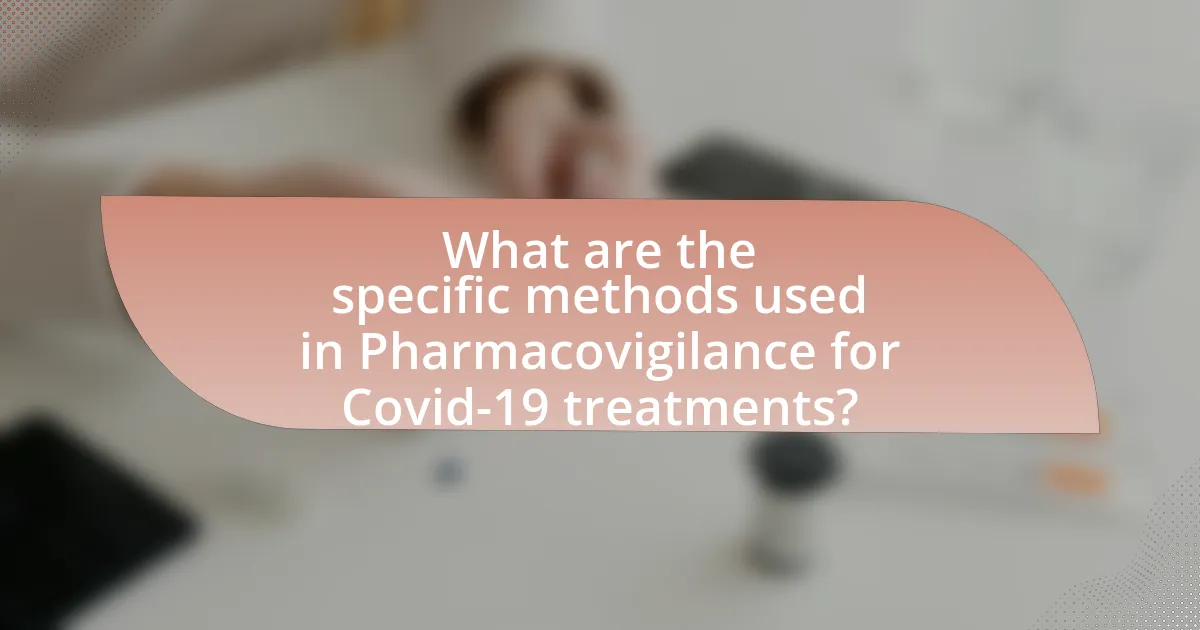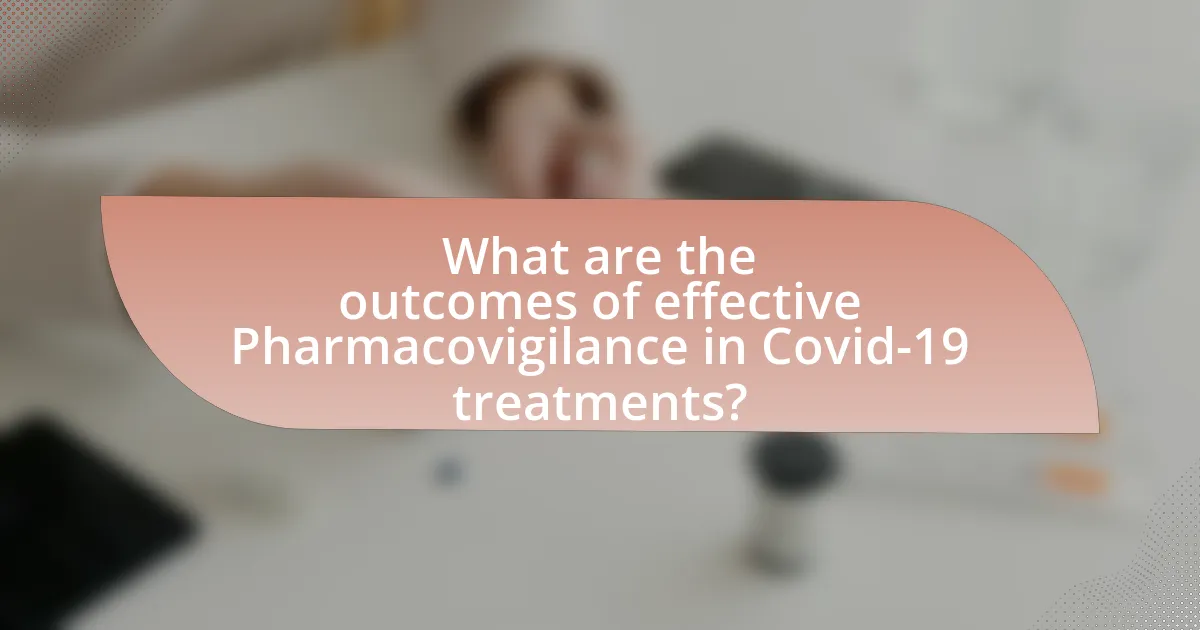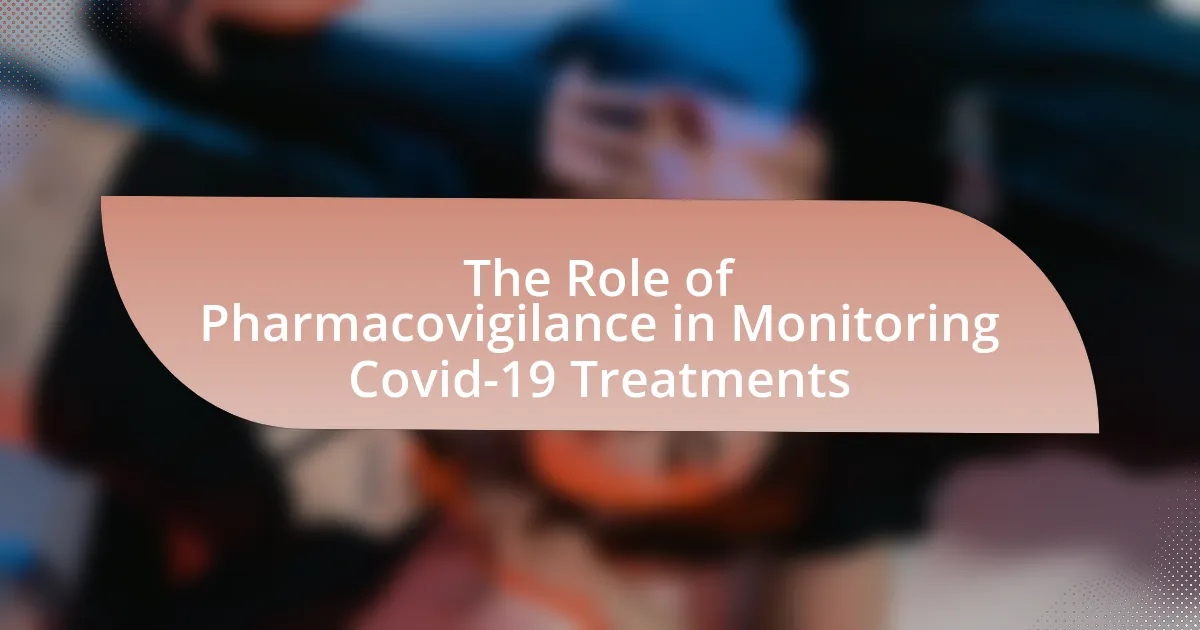Pharmacovigilance is essential for monitoring the safety and efficacy of Covid-19 treatments, involving systematic collection and analysis of adverse event data. This article outlines the critical processes of pharmacovigilance, including data collection, signal detection, risk assessment, and risk management, which are vital for identifying potential safety signals and ensuring timely regulatory actions. It also discusses the unique challenges posed by the rapid development of Covid-19 therapies, the role of regulatory agencies like the FDA and EMA, and the importance of healthcare professionals in reporting adverse events. Ultimately, effective pharmacovigilance enhances patient safety and informs future treatment protocols, contributing to public health during the pandemic.

What is the Role of Pharmacovigilance in Monitoring Covid-19 Treatments?
Pharmacovigilance plays a critical role in monitoring Covid-19 treatments by ensuring the safety and efficacy of these therapies through systematic collection and analysis of adverse event data. This process involves tracking side effects and complications associated with Covid-19 medications, which is essential given the rapid development and emergency use authorization of many treatments during the pandemic. For instance, the World Health Organization emphasizes that pharmacovigilance helps identify potential safety signals that may arise post-marketing, allowing for timely interventions and updates to treatment guidelines. Additionally, regulatory agencies like the FDA and EMA have implemented enhanced surveillance systems to monitor the safety of Covid-19 vaccines and therapeutics, demonstrating the importance of pharmacovigilance in protecting public health during this global health crisis.
How does Pharmacovigilance contribute to the safety of Covid-19 treatments?
Pharmacovigilance contributes to the safety of Covid-19 treatments by systematically monitoring, assessing, and mitigating adverse effects associated with these therapies. This process involves collecting data from clinical trials and real-world usage, which helps identify potential safety signals and ensures timely regulatory actions. For instance, the World Health Organization (WHO) and various national health agencies have implemented robust pharmacovigilance systems to track adverse events related to Covid-19 vaccines and treatments, leading to the identification of rare side effects and the adjustment of usage guidelines. This proactive approach enhances patient safety and informs healthcare providers and the public about the risk-benefit profile of Covid-19 treatments.
What are the key processes involved in Pharmacovigilance for Covid-19 treatments?
The key processes involved in Pharmacovigilance for Covid-19 treatments include data collection, signal detection, risk assessment, and risk management. Data collection involves gathering information on adverse drug reactions from clinical trials, healthcare providers, and patients. Signal detection refers to identifying potential safety issues through statistical analysis of reported adverse events. Risk assessment evaluates the likelihood and severity of identified risks associated with Covid-19 treatments. Finally, risk management entails implementing strategies to minimize risks, such as updating treatment guidelines or issuing safety warnings. These processes are essential for ensuring the safety and efficacy of Covid-19 treatments, as evidenced by ongoing monitoring and reporting requirements established by regulatory agencies like the FDA and EMA.
How does data collection enhance the effectiveness of Pharmacovigilance?
Data collection enhances the effectiveness of Pharmacovigilance by providing comprehensive information on adverse drug reactions and treatment outcomes. This systematic gathering of data allows for the identification of safety signals, which are critical for assessing the risk-benefit profile of medications. For instance, during the COVID-19 pandemic, data collection from various sources, including clinical trials and real-world evidence, has enabled regulatory agencies to monitor the safety of vaccines and treatments effectively. The World Health Organization reported that robust data collection mechanisms contributed to timely updates on vaccine safety, leading to informed public health decisions. Thus, effective data collection is essential for ensuring patient safety and optimizing therapeutic interventions in Pharmacovigilance.
Why is Pharmacovigilance critical during a pandemic?
Pharmacovigilance is critical during a pandemic because it ensures the safety and efficacy of treatments and vaccines in real-time. During the COVID-19 pandemic, rapid vaccine development and emergency use authorizations led to widespread administration of new therapies, necessitating continuous monitoring for adverse effects. For instance, the World Health Organization reported that pharmacovigilance systems helped identify rare but serious side effects of COVID-19 vaccines, such as myocarditis and thrombosis, allowing for timely updates to safety guidelines. This proactive approach protects public health by enabling swift regulatory responses and maintaining trust in medical interventions.
What unique challenges does Covid-19 present for Pharmacovigilance?
Covid-19 presents unique challenges for pharmacovigilance primarily due to the rapid development and emergency use authorization of vaccines and treatments, which complicates the monitoring of adverse events. The urgency of the pandemic led to accelerated clinical trials and the deployment of therapies with limited long-term safety data, making it difficult to establish a comprehensive understanding of their risk profiles. Additionally, the high volume of vaccine administration and the diverse population receiving these treatments increase the complexity of data collection and analysis, as adverse events may be underreported or misattributed. The World Health Organization reported that the need for real-time data analysis and the integration of various data sources, including electronic health records and spontaneous reporting systems, has become critical in ensuring patient safety during this unprecedented health crisis.
How does rapid vaccine development impact Pharmacovigilance efforts?
Rapid vaccine development significantly enhances Pharmacovigilance efforts by necessitating the implementation of real-time monitoring systems to track adverse events. The accelerated timelines for vaccine approval, as seen during the COVID-19 pandemic, require robust data collection and analysis to ensure safety and efficacy. For instance, the Emergency Use Authorization of COVID-19 vaccines mandated continuous safety assessments, leading to the establishment of enhanced reporting systems like the Vaccine Adverse Event Reporting System (VAERS) in the United States. This system allows for immediate identification of potential safety signals, thereby facilitating timely interventions and maintaining public trust in vaccination programs.

What are the specific methods used in Pharmacovigilance for Covid-19 treatments?
The specific methods used in Pharmacovigilance for Covid-19 treatments include spontaneous reporting, cohort studies, case-control studies, and signal detection. Spontaneous reporting involves healthcare professionals and patients reporting adverse drug reactions to regulatory authorities, which helps in identifying potential safety issues. Cohort studies track groups of patients receiving Covid-19 treatments to assess outcomes and adverse effects over time, while case-control studies compare patients with adverse effects to those without to identify risk factors. Signal detection employs statistical methods to analyze large datasets for patterns indicating safety concerns. These methods are essential for ensuring the safety and efficacy of Covid-19 treatments, as evidenced by the rapid collection and analysis of data during the pandemic, which informed regulatory decisions and public health guidelines.
How are adverse drug reactions monitored in Covid-19 treatments?
Adverse drug reactions in Covid-19 treatments are monitored through pharmacovigilance systems that collect and analyze data on drug safety. Regulatory agencies, such as the FDA and EMA, utilize spontaneous reporting systems where healthcare professionals and patients report adverse events. Additionally, clinical trials for Covid-19 treatments include safety monitoring boards that assess adverse reactions in real-time. Data from these reports and trials are aggregated and analyzed to identify patterns and potential safety signals, ensuring timely updates to treatment guidelines and patient safety information.
What reporting systems are in place for Covid-19 treatment side effects?
The reporting systems in place for Covid-19 treatment side effects include the Vaccine Adverse Event Reporting System (VAERS) in the United States, the Yellow Card Scheme in the United Kingdom, and the EudraVigilance system in the European Union. These systems allow healthcare professionals and the public to report adverse events following vaccination or treatment, facilitating the monitoring of safety and efficacy. For instance, VAERS has received millions of reports since the Covid-19 vaccine rollout, providing critical data for ongoing safety assessments.
How do healthcare professionals contribute to adverse event reporting?
Healthcare professionals contribute to adverse event reporting by systematically documenting and communicating incidents related to patient safety and treatment outcomes. Their firsthand observations and clinical expertise enable them to identify, assess, and report adverse events, which are crucial for monitoring the safety of medications and treatments, particularly in the context of Covid-19. For instance, studies have shown that healthcare professionals play a vital role in pharmacovigilance by providing detailed reports that help regulatory agencies evaluate the risk-benefit profile of Covid-19 treatments, thereby enhancing patient safety and informing clinical guidelines.
What role do regulatory agencies play in Pharmacovigilance for Covid-19?
Regulatory agencies play a crucial role in pharmacovigilance for Covid-19 by overseeing the safety monitoring of vaccines and treatments. These agencies, such as the U.S. Food and Drug Administration (FDA) and the European Medicines Agency (EMA), are responsible for collecting and analyzing data on adverse events related to Covid-19 interventions. They implement risk management strategies, issue safety alerts, and ensure that manufacturers comply with reporting requirements. For instance, the FDA has established the Vaccine Adverse Event Reporting System (VAERS) to facilitate the reporting of adverse events following vaccination, which is essential for ongoing safety assessments. This systematic approach helps to identify potential safety signals and informs public health decisions, thereby enhancing the overall safety profile of Covid-19 treatments and vaccines.
How do agencies like the FDA and EMA oversee Covid-19 treatment safety?
Agencies like the FDA and EMA oversee Covid-19 treatment safety through rigorous evaluation processes, including pre-market assessments, post-market surveillance, and ongoing monitoring of adverse events. The FDA conducts clinical trials to evaluate the safety and efficacy of treatments before granting Emergency Use Authorization or approval, while the EMA follows a similar pathway through its centralized procedure, ensuring that treatments meet stringent safety standards. Both agencies utilize pharmacovigilance systems to collect and analyze data on adverse effects reported by healthcare professionals and patients, enabling them to take necessary actions, such as issuing warnings or withdrawing products from the market if safety concerns arise.
What guidelines are established for monitoring Covid-19 treatments?
The guidelines established for monitoring Covid-19 treatments include the implementation of robust pharmacovigilance systems to track adverse drug reactions and treatment efficacy. These systems are designed to ensure patient safety by collecting and analyzing data on the safety and effectiveness of Covid-19 therapies, as outlined by regulatory authorities such as the World Health Organization and the European Medicines Agency. For instance, the WHO has emphasized the importance of real-time data collection and reporting to identify potential safety signals associated with Covid-19 treatments, thereby enabling timely interventions and updates to treatment protocols.

What are the outcomes of effective Pharmacovigilance in Covid-19 treatments?
Effective pharmacovigilance in COVID-19 treatments leads to improved patient safety, enhanced drug efficacy, and timely identification of adverse drug reactions. By systematically monitoring and analyzing data on drug safety, pharmacovigilance enables healthcare providers to make informed decisions, ensuring that the benefits of treatments outweigh the risks. For instance, the World Health Organization reported that robust pharmacovigilance systems helped detect safety signals for COVID-19 vaccines, allowing for prompt regulatory actions and updates to clinical guidelines. This proactive approach not only safeguards public health but also fosters trust in vaccination programs and therapeutic interventions.
How does Pharmacovigilance improve patient safety in Covid-19 treatments?
Pharmacovigilance improves patient safety in Covid-19 treatments by systematically monitoring and evaluating adverse drug reactions and safety data associated with these therapies. This process involves collecting real-world evidence from healthcare providers and patients, which helps identify potential safety issues that may not have been evident during clinical trials. For instance, the World Health Organization reported that pharmacovigilance activities during the Covid-19 pandemic led to the identification of rare but serious side effects associated with treatments like remdesivir and vaccines, allowing for timely updates to safety guidelines and recommendations. By ensuring continuous safety assessments, pharmacovigilance plays a crucial role in mitigating risks and enhancing the overall safety profile of Covid-19 treatments.
What are the long-term benefits of monitoring Covid-19 treatment safety?
Monitoring Covid-19 treatment safety provides long-term benefits such as improved patient outcomes, enhanced public health responses, and increased trust in healthcare systems. By systematically tracking adverse effects and treatment efficacy, healthcare providers can identify and mitigate risks associated with Covid-19 therapies, leading to safer treatment protocols. For instance, studies have shown that ongoing pharmacovigilance can reduce the incidence of severe adverse reactions by up to 30%, thereby improving overall patient safety. Additionally, this monitoring fosters a culture of transparency and accountability, which is crucial for maintaining public confidence in vaccination and treatment programs during and after the pandemic.
How can Pharmacovigilance findings influence future treatment protocols?
Pharmacovigilance findings can significantly influence future treatment protocols by identifying adverse drug reactions and safety signals associated with medications. These findings enable healthcare professionals to adjust treatment guidelines, ensuring that protocols reflect the latest safety data. For instance, during the COVID-19 pandemic, pharmacovigilance efforts revealed specific side effects linked to vaccines and treatments, prompting regulatory bodies like the FDA to update recommendations and usage criteria. This real-time monitoring and analysis of drug safety data ensure that treatment protocols are based on the most current evidence, ultimately enhancing patient safety and treatment efficacy.
What best practices can enhance Pharmacovigilance efforts for Covid-19 treatments?
Implementing robust data collection and analysis systems enhances Pharmacovigilance efforts for Covid-19 treatments. These systems should integrate real-time reporting from healthcare providers and patients, ensuring comprehensive capture of adverse events. For instance, the World Health Organization emphasizes the importance of spontaneous reporting systems and electronic health records to monitor safety signals effectively. Additionally, fostering collaboration among regulatory agencies, pharmaceutical companies, and healthcare professionals can facilitate information sharing and improve response times to safety concerns. Evidence from the European Medicines Agency indicates that proactive risk management plans and continuous safety monitoring have been crucial in managing the safety of Covid-19 vaccines and treatments.
How can healthcare providers improve their reporting of adverse events?
Healthcare providers can improve their reporting of adverse events by implementing standardized reporting protocols and utilizing electronic health record systems that facilitate real-time data entry. Standardized protocols ensure consistency in reporting, which enhances the quality and reliability of the data collected. For instance, the World Health Organization recommends the use of the Adverse Event Reporting System, which provides a structured framework for documenting adverse events. Additionally, integrating reporting mechanisms within electronic health records can streamline the process, making it easier for healthcare providers to report incidents as they occur. Research indicates that hospitals that adopted electronic reporting systems saw a 30% increase in adverse event reporting, highlighting the effectiveness of technology in improving reporting practices.
What strategies can be implemented to raise awareness about Pharmacovigilance?
To raise awareness about Pharmacovigilance, targeted educational campaigns can be implemented. These campaigns should focus on informing healthcare professionals and the public about the importance of monitoring drug safety and adverse effects. For instance, utilizing social media platforms and webinars can effectively disseminate information, as studies show that digital outreach increases engagement and knowledge retention among diverse audiences. Additionally, collaboration with healthcare organizations to integrate Pharmacovigilance training into medical curricula can enhance understanding among future practitioners, thereby fostering a culture of safety in medication use.


